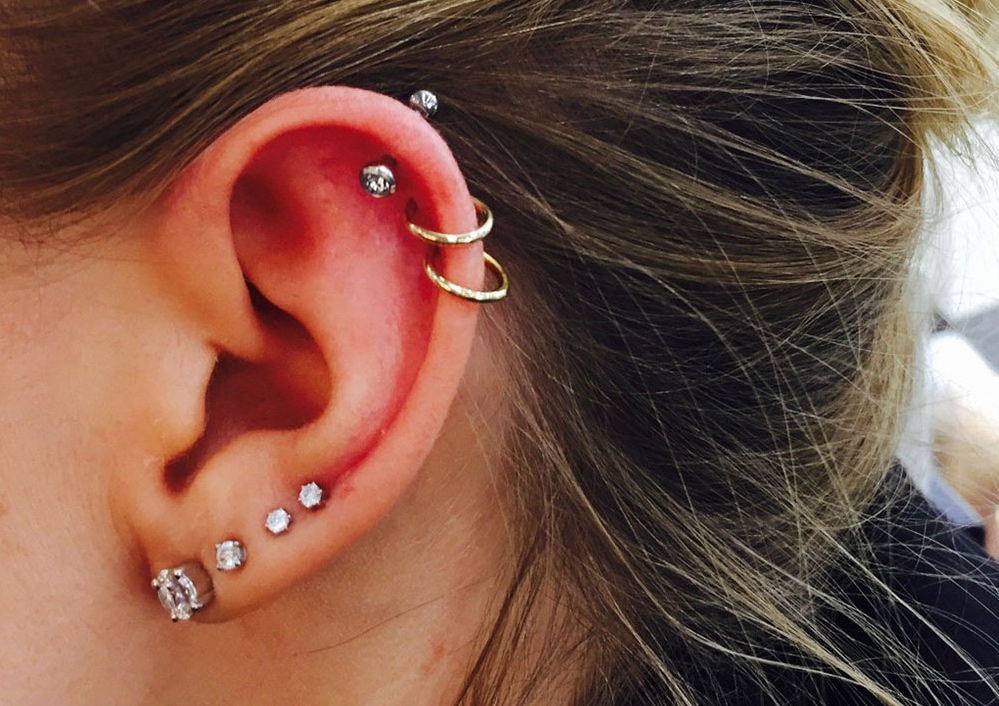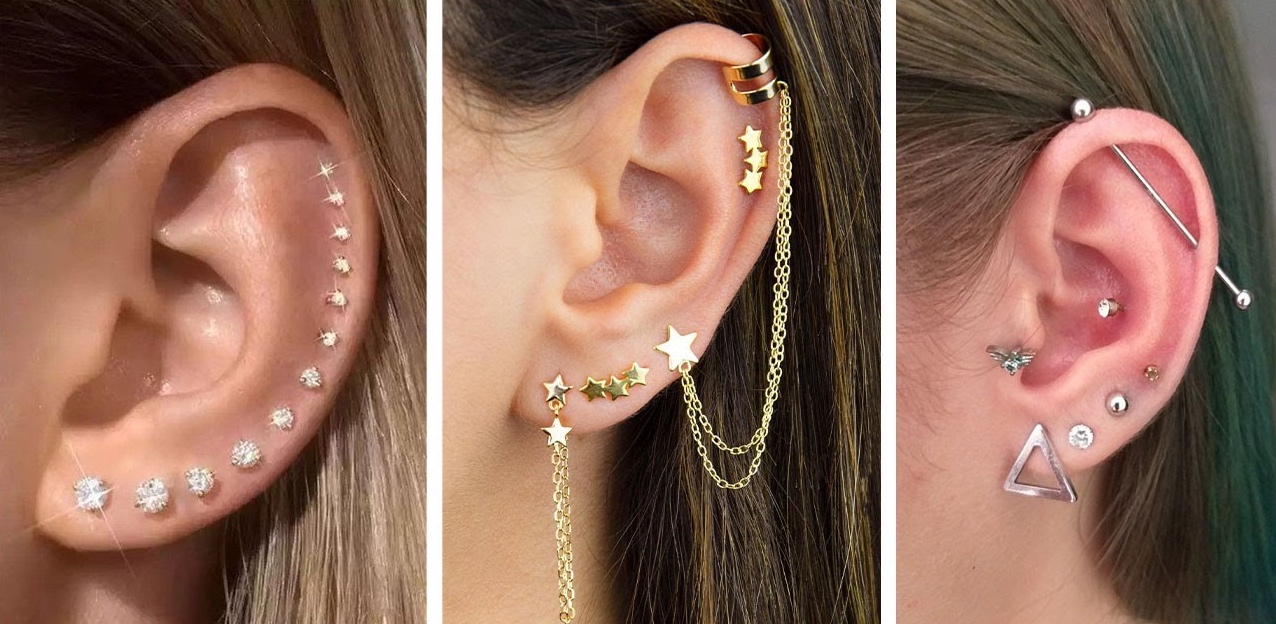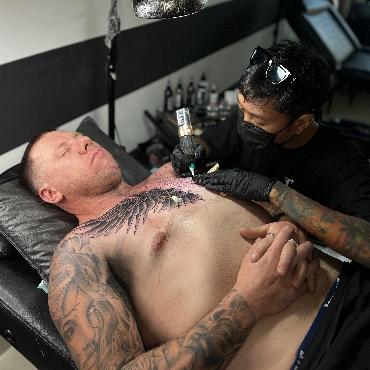Discussion on how to keep your piercing clean. All piercings are placed with a sterilised bar of Titanium. Titanium is hypo-allergenic and contributes to the optimal healing of your piercing. The average healing time for cartilage piercings is about 9 months to a year. After about 3 to 4 months you can change your rod for a shorter version. Of course you can leave your original piercing in longer. Scar tissue needs a full 9 months to regain strength. Changing too soon or too often can cause this process to slow down and the healing to take longer.
When you want to change your piercing, make sure you work sterile and use a piercing clamp to hold your rod and a screw ball tool to loosen and tighten your ball. After healing you can replace the jewelry for a ring or barbell that suits you. Visit the store for new jewellery to replace your piercing when you are ready.
Extra information for an irritated or inflamed piercing
When you have just had your piercing inserted, your piercing is still an open wound and it can feel painful, stinging and irritated for the next few days or even weeks. Around your piercing scabs can develop, dirt or blood can come out and your piercing can look thick, red and swollen. This is a very normal process and nothing to worry about.
However, you do need to keep a close eye on any inflammation or irritation and your piercing needs proper care. Change your piercing only when your piercing is really healed, this can take 3 to 9 months. Your piercing will not heal by itself. So make sure you take care of it properly, 2 times a day when you get up and before you go back to sleep.
Do not touch your piercing unnecessarily, do not play with it, watch out for bumps and do not sleep on it. For ear piercings, use a round travel pillow that you can close at the bottom and put your ear in the hole so you don’t lie on it. Make sure you have some space on both sides of your piercing jewellery so that your piercing doesn’t pinch and to prevent moisture from escaping. After sleeping, showering or cleaning your piercing, always check that your ball(s) are still tight. What is screwed on, can also be loosened by e.g. vibration.
Never take out your irritated or inflamed piercing to prevent the inflammation from getting into the wound. Always leave your piercing(s) in place during any treatment with salt, soda, healing oil or antibiotics. Always wash your hands thoroughly before touching your piercing or put on gloves. If you have a fever, contact your doctor for antibiotics. Even then don’t take your piercing out (or have it taken out).
For an irritated or inflamed piercing, use a physiological saline solution spray for your piercing once a day and dip your piercing in a soda or sea salt solution once a day. (For surface piercings or microdermals, instead of dipping, you can dip a cotton pad in the soda or sea salt solution and place it on your piercing until it dries and repeat daily until your piercing no longer feels irritated).

Piercing Dipping Application
Bring water to a boil and place in a glass of about 200/250ml. Dissolve 1 teaspoon of (baking) soda or pure sea salt without iodine and let it cool down until the solution is warm to the touch. If the solution is too hot for your finger, it will also be too hot for your piercing. Hand warm, but not lukewarm is the best temperature. To care for your ear piercing, put a towel around your neck, put a cotton ball in your ear, tilt your head and hold the glass with the soda solution over your ear so that your ear is submerged. It looks a bit ridiculous, but soak your ear in this for about 5 minutes.
Do this once a day to prevent dehydration and combine this once a day with a physiological saline spray. (e.g. dip in the morning and spray at night, or vice versa, just what works for you) You can use this method on most piercings to soak your piercing. To care for mouth lip or tongue piercings, use the solution to rinse your mouth with. A Physiological saline solution is not suitable for in your mouth.
Application of moisture bumps
Bring water to a boil and place in a glass of about 200/250ml. Dissolve 1 generous teaspoon of baking soda or sea salt solution and let it cool until the solution is warm to the touch. If the solution is too hot for your finger, it will also be too hot for your piercing. Hand warm, but not lukewarm is the best temperature.
Now take 2 cotton swabs and dip them into the solution. Hold the swabs on both sides on your moisture bump and “clamp” the bump as it were between your swabs to exert a slight pressure and hold this for about 3 minutes. Repeat this step 1x a day 3x 3 min. Do not rub, scratch or puncture the lump, a light pressure with the salt or soda solution is sufficient. Continue the treatment until your lump is gone. This can take between 4 and 8 weeks. You can combine this treatment with silicone healing discs.
How do you clean your piercing?
When showering, use a 0% soap that does not contain silicones or perfumes. Wash your body as you always do, without touching your piercing. Rinse your piercing with water and after showering gently pat it dry all around with a clean towel. Spray your piercing with a physiological saline solution and let it air dry. If you feel more comfortable using a cotton swab, you can of course do that too.
Always make sure you have clean hands when you go to clean your piercing. Do not pull off any crusts. Using the spray twice a day is sufficient. When you move a lot in your sleep, cover your piercing with a piece of gauze. Preferably not a plaster, since your piercing needs to “breathe”. Sleep under clean bedding and do not sleep under a wool blanket. Remove the gauze immediately when you get up. Do not touch your piercing, do not play with it and do not wear tight clothing that could compress your piercing.




